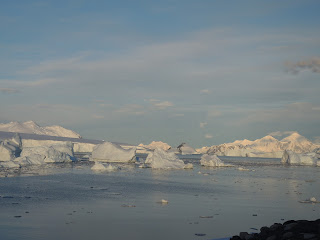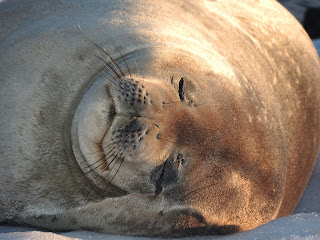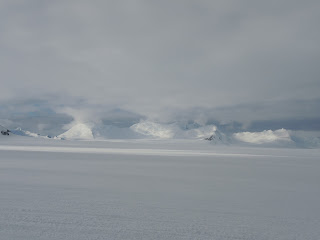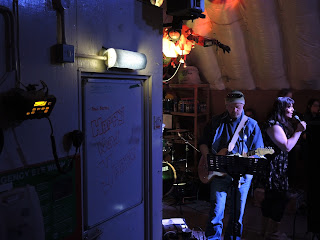HAPPY NEW YEAR from Antarctica! I have now been here
for exactly one week, after leaving Punta Arenas, Chile, on Christmas Day. We
had a lovely Christmas dinner immediately after landing here. Like during my
previous trip to Rothera in Dec. 2010-Jan. 2011, I bailed out from the party at
about 10.30 pm and went for a hike around Rothera Point (the peninsula on which
the base is built – since it is one of the few places in the area of a
relatively even surface which is partly ice-free) under the midnight sun. I
very much enjoy the serenity of the polar environment, together with watching
active wildlife at this time of the night. And the light of the midnight sun
(with a higher proportion of the “red” part of the spectrum compared to
mid-day) makes everything illuminated in it even more pretty. Indeed, these
walks under the midnight sun have become an important part of my daily activity
cycle here – also because I find it very difficult to simply go to sleep in the
evening when there is still intense sunlight outside.
All of the mandatory inductions which one has to do
before being allowed to start any work in Antarctica are now behind me, and
serious work (yes, diving!) should start soon... maybe as early as tomorrow
hopefully. I had deliberately timed my arrival around Christmas so that I would
not lose any real work time for these lengthy inductions, but also for having a
few days to acclimatize and to simply enjoy the beautiful nature here. One
issue that we need to sort out is that the RRS James Clark Ross (nicknamed
"JCR") which was meant to bring most of a year's worth of supplies to
Rothera (including my 2 boxes with scientific and diving equipment) couldn't
get here - too much sea ice (even though it is an ice-strengthened vessel)!! It
had to return to the Falkland Islands where part of its cargo (including my
equipment) were reloaded onto the HMS Protector, a stronger ice breaker of the
Royal Navy, which is meant to get here at some point next week... but there
should be some spare dry suits and dive equipment at the Bonner Lab.
I should write a bit about the training and inductions
that one has to do when arriving in Antarctica. They include communications on
and off base, living and working around aircraft, personal management in the
polar environment, field meteorological observations, life and work in
deep-field sites, field medical box training, vehicle operation, and an
induction of the Bonner Marine Lab.
The latter is named after Nigel Bonner (1928-1994),
one of the founding fathers of Antarctic marine mammal biology[1]. I fondly remember
personally meeting Bonner at the first scientific conference that I attended in
my life – which was the 1991 SCAR (Scientific Committee for Antarctic Research)
Conference in Bremen, which was just a few weeks after graduating from high
school (at 19 years of age, I was the youngest participant!) due to my already
then strong enthusiasm for Antarctic science.
Life in Antarctica is not
only about seals, penguins, diving, flying and beautiful scenery like from
another world... a base like this (currently housing 55 people, less than half
its full capacity) also needs to be fed and kept clean! While there is a
kitchen staff of 3, they are supplemented by the gash rota system, i.e.
everyone else needs to help out with cleaning jobs one day every 6 weeks or so.
I had my day of gash on Dec. 30 – I had deliberately asked to do it early on
during my stay here, since the delayed arrival of my equipment means that I
will be very busy and time will be a premium once it finally gets here.
Food on base is very good. The chefs are clearly
highly skilled and motivated – it is obvious that good food makes a big
difference for morale of scientists and staff in such a place.
During the last afternoon of the year 2017, I hiked to
the Caboose, a cabin on sledges on the glacier beneath Reptile Ridge. This is
part of the “local travel area” which we are allowed to access on foot, skis,
or with a snow mobile without being accompanied by a field guide. The area is
clearly marked by a flag line and is big enough for a nice hike or a bit of
cross-country skiing for a couple of hours. Going uphill, it took me 2 hours to
get there. When reaching the Caboose, I rested for about 30 min, before heading
back.
And then, it was the New Year’s Eve party! The
organizers had chosen to hold it in the boat shed near the Biscoe Wharf, which
was a great idea. Rothera is arguably one of the coolest places (literally) on
Planet Earth for such a party. Shortly before midnight, we all ascended Cross
Hill above the buildings of the base (the site of the memorial for scientists
and staff who have perished while working at Rothera over the years)[2] where we welcomed 2018
under a beautiful midnight sun setting. At 0 am, we hugged each other,
exchanged wishes and stayed for a few minutes enjoying the awesome scenery –
before heading either to bed or to the bar in the New Bransfield House.
(Click
on the images for a full-screen, high-resolution view.
You can browse by using the cursor buttons.)
You can browse by using the cursor buttons.)
North Cove under the midnight sun
View from Rothera Point towards Pourquoi Pas Island
(The "Pourquoi Pas?" was the vessel of Charcot's French Antarctic expedition, which explored this area in 1908-1910)
Dec. 25
(The "Pourquoi Pas?" was the vessel of Charcot's French Antarctic expedition, which explored this area in 1908-1910)
Dec. 25
View from Rothera Point towards the Arrowsmith Peninsula, Antarctic Mainland
View from Rothera Point towards Alexander Island
Antarctic skua at Rothera Point
View from Rothera Point towards the Arrowsmith Peninsula, Antarctic Mainland
View from Rothera Point towards Pourquoi Pas Island and Alexander Island
Cheshire Island, SW of Rothera Point - this had been one of my main dive sites in 2010-2011.
Now it's full of elephant seals!
Elephant seals mock fighting, Cheshire Island
View from Rothera Point towards the Arrowsmith Peninsula, Antarctic Mainland
Elephant seals on Cheshire Island
View from Rothera Point towards Jenny Island in the midnight sun
View from Rothera Point towards Reptile Ridge and the bay left by the receding Sheldon Glacier
in the midnight sun
in the midnight sun
The memorial for the scientists who have perished while working at Rothera
View from Rothera Point towards Jenny Island in the midnight sun
New Bransfield House and Mt. Liotard in the midnight sun
North Cove in the midnight sun
Crabeater seal
Crabeater seal
Crabeater seal
Crabeater seal
Elephant seal
Crabeater seal
View from Rothera Point towards the Arrowsmith Peninsula, Antarctic Mainland
A Basler BT-67 on its stopover visit on the way back to Canada. In the photo you can see the skis being removed before the long flight from here to North America. This is an approx. 70 year-old air frame of a McDonnel Douglas DC3, but entirely rebuilt and with new engines - a perfect, sturdy work horse plane for the polar regions. Basler Turbo Conversions Inc., of Oshkosh, Wisconsin, is specialized on rebuilding historic air frames for use as utility aircraft in the 21st century.
Basler BT-67, with one set of skis still on, and the other one removed
Basler BT-67, with one set of skis being loaded into the cabin before the long flight back to Canada
Elephant seals are everywhere...
Elephant seal obstructing the aircraft runway
Elephant seals are everywhere...
Elephant seals are everywhere...
Elephant seals are everywhere...
Weddell seal, North Cove, in the midnight sun
Weddell seal, North Cove, in the midnight sun
Weddell seal, North Cove, in the midnight sun
View from North Cove towards the Arrowsmith Peninsula, Antarctic Mainland
View from North Cove towards the Arrowsmith Peninsula, Antarctic Mainland:
Elephant seals are fighting among the ice floes
Elephant seals are fighting among the ice floes
Elephant seals are fighting among the ice floes
View from North Cove towards the Arrowsmith Peninsula, Antarctic Mainland:
Elephant seals are fighting among the ice floes
Elephant seals are fighting among the ice floes
Elephant seals are fighting among the ice floes
Weddell seal
View from North Cove towards the Arrowsmith Peninsula, Antarctic Mainland
View from North Cove towards the Arrowsmith Peninsula, Antarctic Mainland
North Cove
North Cove
North Cove
Hangar Cove
Hangar Cove, midnight sun
Skuas above Hangar Cove, midnight sun
Runway, midnight sun
Runway, midnight sun
Elephant seal blocking the access road to the runway
Elephant seal blocking the access road to the runway: I was tempted to wipe its nose...
New Bransfield House, which contains the canteen, library and bar,
with 4 gator trucks parked in front of it
with 4 gator trucks parked in front of it
Mt. Liotard (2,225 metres high!) and, in front of it, Leonie Island (resembling a black trapezoid)
Mt. Liotard (2,225 metres high!) and, in front of it, Leonie Island (resembling a black trapezoid)
Iceberg off Rothera Point
The first two Adelie penguins encountered on this trip!
The first two Adelie penguins encountered on this trip!
Iceberg off Rothera Point
Fieldwork training - here: how to operate a kerosene lamp
Fieldwork training - here: inspecting the contents medical and food supply boxes
Fieldwork training - here:
How to set up a tent (of the light weight type that is carried on a Twin Otter)
How to set up a tent (of the light weight type that is carried on a Twin Otter)
Rothera Point, view towards Jenny Island in the midnight sun
Crabeater seal, Rothera Point
Crabeater seal, Rothera Point
Crabeater seal, Rothera Point
Rothera Point, view towards Jenny Island in the midnight sun
Rothera Point in the midnight sun
Rothera Point in the midnight sun
Rothera Point, view towards Jenny Island in the midnight sun
Icebergs and elephant seals at Rothera Point
View from Rothera Point towards Jenny Island
Icebergs at Rothera Point
The site of Julia Kleinteich's chamber experiments (studying cyanobacterial mat composition under simulated climate change) in 2010-2011
Rothera Point, view towards the Arrowsmith Peninsula in the midnight sun
Hiking Rothera Point in the midnight sun
Moon and antenna cables at Rothera Point
Shelf ice edge at the "Ramp", west of the runway
Skua at the memorial, Rothera Point
The BAS Sledge Dog Memorial
The moon above Reptile Ridge
The moon above Reptile Ridge
Recycling span
Control tower
Rothera Medical Surgery
The RO desalination plant, which provides drinking / tap water for the base.
The four generators providing electricity and heat to the base. Given how much sunlight there is in summer and also considering the high cost and carbon footprint of burning diesel in Antarctica, it would make a lot of sense to install PV panels on the buildings!
De Havilland Canada Twin Otter returning from a deep-field mission
The Rothera Marine Team heading out for a day at sea
The aquarium in the Bonner Marine Lab
Part of the mandatory training and inductions: medical training for fieldwork
North Cove in the midnight sun
Elephant seal among ice floes, Hangar Cove
Icebergs in North Cove, midnight sun
Icebergs in North Cove, midnight sun
Fighting elephant seals, North Cove
Bonner Marine Lab seen from the entrance of Giants' House (where I am staying) in the midnight sun. Note the drifting ice in the bay!
View from Biscoe Wharf to the ice edge at Rothera Point and towards Pourquoi Pas Island.
Rothera Point, view towards Pourquoi Pas Island
Rothera Point, view towards Jenny Island on the horizon in the midnight sun
Elephant seals, North Cove
Elephant seals are everywhere!
Elephant seal in front of New Bransfield House
Elephant seal in front of New Bransfield House
View of the base from the northern end of the runway
North Cove
Hangar Cove
Weddell seal, Hangar Cove
Weddell seal, Hangar Cove
My day of gash - Dec. 30
My day of gash - Dec. 30
The Rothera kitchen
Store room of the Rothera kitchen for near-immediate use - there are much bigger food stores elsewhere on base, which are sufficient for 18 months
Rothera Point, view towards Jenny Island on the horizon in the midnight sun
View of Cheshire Island in the foreground from Rothera Point
Rothera Point, view towards Jenny Island on the horizon in the midnight sun
Kelp gulls on the cliffs at Rothera Point in the midnight sun
Crabeater seal, Rothera Point
View of the base and Mt. Liotard from the north end of Rothera Point
The last afternoon of 2017: My hike up the "Ramp" to the Caboose
Dec. 31
The last afternoon of 2017: My hike to the Caboose.
The flag line marks the safe passage identified by the bases field guides (guaranteed to be free of crevasses!)
The flag line marks the safe passage identified by the bases field guides (guaranteed to be free of crevasses!)
Dec. 31
View during the hike towards the Arrowsmith Peninsula
After 2 h, I finally reached the Caboose
Inside the Caboose, I rested a bit for about half an hour...
...then I called Ops in the base's control tower before heading back, using this VHF radio.
Selfie taken before leaving the Caboose
The Nansen sledge which is parked close to the Caboose. A sledge developed during the pioneering years of polar explorations and named after Fridtjof Nansen, the Norwegian polar explorer and recipient of the Peace Nobel Prize (Nansen and I have the same first name, but with a slightly different spelling). This one is used for storing fuel away from the Caboose.
Dec. 31
Dec. 31
Antarctic solitude north of the trail back to base - glaciers and mountains of Adelaide Island, not a single living being
Dec. 31
Glacier, icebergs and, in the background, the Arrowsmith Peninsula seen during the hike back to base
Icebergs seen during the hike back to base
My return to base coincided with the arrival of the Dash-7 from Santiago de Chile and Puerto Montt with important scientific cargo and an extra pilot to Rothera. With this aircraft, it takes around 10 h in the air to get to Santiago one-way.
Dec. 31
Dec. 31
My return to base coincided with the arrival of the Dash-7 from Santiago de Chile and Puerto Montt with important scientific cargo and an extra pilot to Rothera. With this aircraft, it takes around 10 h one-way in the air to get to Santiago.
Dec. 31
Dec. 31
My return to base coincided with the arrival of the Dash-7 from Santiago de Chile and Puerto Montt with important scientific cargo and an extra pilot to Rothera. With this aircraft, it takes around 10 h in the air to get to Santiago one-way.
Dec. 31
Dec. 31
Once the Dash-7 had turned off its engines, I was allowed to cross the runway.
After devouring a big dinner (amazing, how much energy one burns during outdoor activities in Antarctica!) there was the New Year's party in the Rothera boatshed. This is Derek from the RAF stocking the beer cooler. Rothera is arguably one of the coolest places (literally) for a party like this.
Dec. 31
Dec. 31
New Year's party in the Rothera boat shed. Note the dummy in the survival dry suit hanging from the ceiling above the stage.
Dec. 31
Dec. 31
With Al (the Dash-7 pilot, left) and Lewis (right, one of the chefs) at the party
Dec. 31
Dec. 31
Scenery outside the boat shed during the party
Dec. 31
Dec. 31
Caterpillar crane used for launching Zodiacs etc. for diving and boat explorations of the area
Dec. 31
Dec. 31
Caterpillar crane used for launching Zodiacs etc. for diving and boat explorations of the area
Dec. 31
Dec. 31
The boat shed (the greenish building to the right of the center) was the venue of the 2017-2018 Rothera New Year's Eve party
Dec. 31
Dec. 31
With David Williams from St. Helena, one of the "Saints" of Rothera. David has been living here for almost 10 years now! We had met and become friends during my previous trip to Rothera in 2010-2011.
The party went on...
Dec. 31
Dec. 31
The party went on...
Dec. 31
Dec. 31
Shortly before midnight, we went up Cross Hill to welcome the New Year under the midnight sun
11.57, Dec. 31
11.57, Dec. 31
Welcoming 2018 on the summit of Cross Hill, Rothera
0 am, Jan. 1
0 am, Jan. 1
Welcoming 2018 on the summit of Cross Hill, Rothera
0 am, Jan. 1
0 am, Jan. 1
The official Royal Navy detachment to Antarctica welcomes 2018!
0 am, Jan. 1
0 am, Jan. 1
The official Royal Navy detachment to Antarctica welcomes 2018!
0 am, Jan. 1
0 am, Jan. 1
After a while, we went back inside, where the party continued...
Jan. 1
[1] A
very nice obituary of Bonner’s life and work can be found here: http://onlinelibrary.wiley.com/doi/10.1111/j.1365-2907.1996.tb00154.x/pdf
[2] the
last fatality was a PhD student in 2003, Kirsty Brown, who was very tragically killed by a
leopard seal while snorkelling to survey the impacts of iceberg scouring on
seabed communities.


























































































































































brilliant photos! Have a great time... hear about it when you return!
ReplyDelete